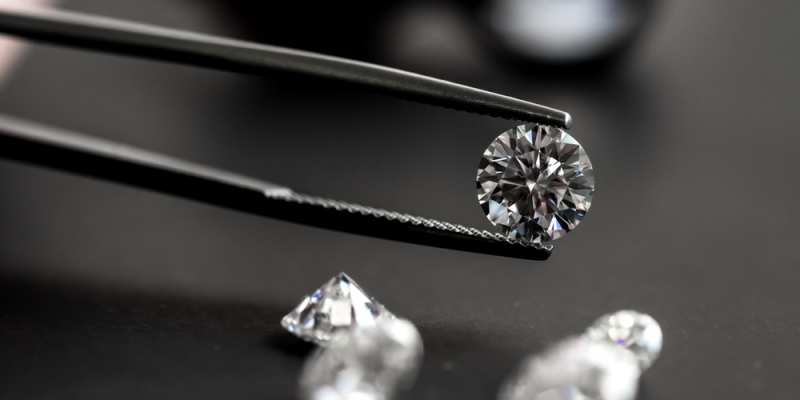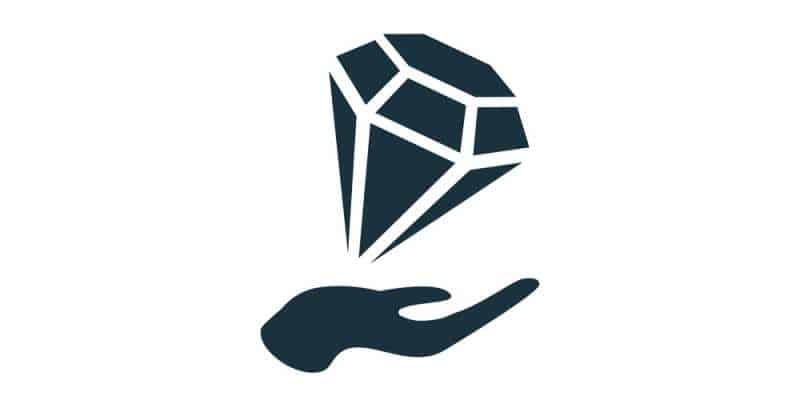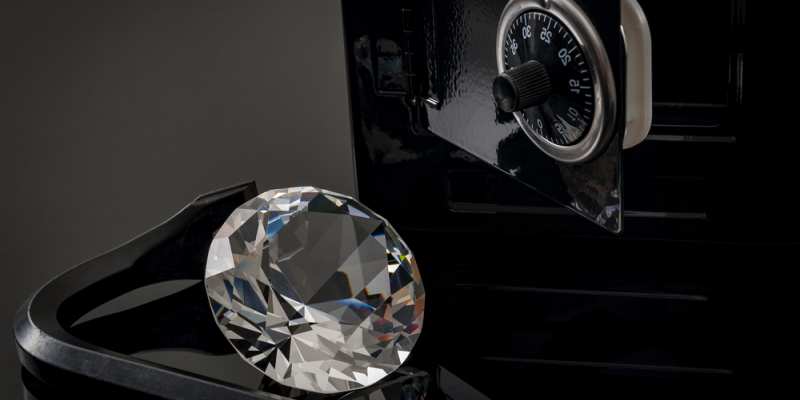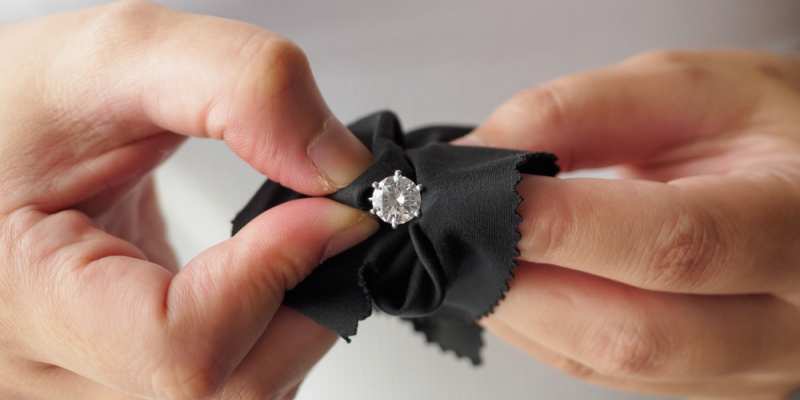Perhaps it was a special birthday gift or a cherished wedding ring. Diamonds not only carry a hefty price tag but also hold sentimental value. Damaging a diamond can be an incredibly stressful situation.
While chipping a nail may be uncomfortable, chipping a diamond can be utterly devastating both financially and emotionally. Despite being renowned as the hardest material on Earth, diamonds are still susceptible to damage, especially if accidentally struck against kitchen countertops or rocks in the garden.
In such instances, your immediate concern might be whether insurance covers a chipped diamond. Once a chip occurs, cracks are likely to follow. In this article, we will explore whether insurance policies cover damaged diamonds, whether the value of the diamond diminishes, and how you can safeguard your jewelry.
Continue reading to find out more!
DESIGN YOUR OWN ENGAGEMENT RING: START WITH A SETTING OR START WITH A DIAMOND. IT’S REALLY UP TO YOU!

Does Insurance Cover A Chipped Diamond?
Unfortunately, the answer to whether insurance covers a chipped diamond isn’t straightforward. The good news is that homeowner’s insurance typically covers diamonds. However, jewelry is often subject to more limited coverage compared to other personal property.
To be more precise, if your diamond gets chipped due to fire or a windstorm, your policy will likely cover the damage. Common insurance-covered perils include fire, explosions, vandalism, and falling objects. Essentially, most natural disasters or accidents beyond your control are covered.
However, it’s important to note that regular homeowner’s insurance usually does not cover damage caused by natural floods, which typically requires an additional flood insurance policy.
If your diamond ring gets chipped from hitting a granite countertop or during house cleaning, it’s unlikely to be covered by insurance. That’s why it’s crucial to know how to properly keep your diamond safe and minimize the risk of chipping.
Although this may seem unfair, there are ways to increase coverage for your precious gems. To mitigate the potential stress of a chipped diamond, you can consider purchasing an additional floater or endorsement.
An insurance endorsement is a modification to your regular insurance policy that adjusts the coverage. By adding an endorsement, you can change what your insurance covers and enhance the terms of your existing policy. This type of addition is also known as scheduled personal property coverage, allowing you to obtain more coverage for specific categories.
On the other hand, an insurance floater functions similarly to an endorsement but focuses on increasing coverage for specific belongings. This option is particularly suitable for diamonds and other valuable items like furs and jewelry.
You might wonder if you can insure a non-certified diamond. The answer is yes, but it’s essential to have it appraised before seeking insurance coverage. Diamond appraisal is crucial as it determines the value of the diamond for insurance purposes.
To have your diamond appraised, you can send it to a professional gemological laboratory where experts will analyze and grade your gem based on various parameters. Upon completion, the laboratory will issue a diamond certificate, which represents the appraised value of your diamond for insurance purposes.
Now that your diamond is certified, you can proceed with insuring it without any issues.

What Type Of Insurance Is Best For Diamonds?
Insuring your jewelry, especially diamonds, is crucial, and it’s advisable to do so as soon as you acquire them. It’s better to be prepared for unforeseen events rather than regretting it later.
As mentioned earlier, basic homeowner’s insurance policies offer limited coverage for jewelry and often exclude certain risks like accidental loss. Typically, these policies cover up to $2,500 worth of jewelry damage. However, when you consider that the average value of an engagement ring ranges from $6,000 to $9,000, it becomes apparent that the coverage is insufficient.
Moreover, the limited payout is only available if you can prove that the jewelry was damaged within your home due to a natural disaster. This is why floaters and endorsements, which we discussed in this article, are excellent options for insuring your diamonds. However, there are even more effective ways to protect your valuable items.
Consider obtaining a separate insurance policy specifically for your gems. A separate policy can fill the gaps left by your homeowner’s insurance and be customized to your desired value and risk coverage.
Additionally, there are insurance policies specialized in jewelry that are worth considering. These specialized policies often collaborate directly with jewelry stores, providing you with more options for exchanges or repairs. However, it’s important to note that this type of specialized insurance typically comes with a higher price tag and is commonly recommended for antique jewelry or customized diamonds.
While having insurance coverage for your diamonds is essential, it’s also valuable to learn how to keep them safe to avoid unnecessary costs and complex paperwork.
Learn More: How Much Does It Cost To Insure A Diamond Ring?
Can You Insure A Lab-Grown Diamond?
Speaking of specialized insurance, let’s address lab-grown diamonds. These diamonds raise specific concerns regarding insuring them in case of damage, theft, or loss.
People sometimes struggle to receive the same value for lab-grown diamonds as they would for natural ones. Naturally, this raises concerns about insurability. However, rest assured that lab-grown diamonds can be insured for the same amount as natural stones, and there are various insurance options available.
One option is self-insurance, where you set aside funds to cover potential damages or financial assistance in case of theft. This option may cost around $2,500 per month but provides a secure alternative if you prefer to avoid the appraisal process.
Alternatively, you can opt for jewelry insurance specifically for lab-grown diamonds. They can be insured similarly to natural diamonds, either through standalone policies or by adding them to your homeowners or renters insurance. However, be aware that these general policies may have lower coverage limits for gemstones.
There are several ways to safeguard yourself and your finances in the event of a chipped diamond, whether it’s a natural or lab-grown one. Now, let’s explore a few ways to proactively keep your diamonds safe.

How To Keep Your Diamond Safe
Even though diamonds are renowned for their hardness, they still require proper care to prevent damage. Due to the uneven hardness along different crystal directions, diamonds can be susceptible to chipping.
Whether you own a single diamond ring or a collection of diamonds, it’s essential to protect them from potential threats that can affect their beauty and value.
Make Wise Purchases
When purchasing diamonds, it’s crucial to make informed decisions. Keep in mind that certain diamond shapes are more prone to chipping than others. Shapes like radiants, triangles, and emerald cuts have a higher risk of chipping compared to rounder diamonds. Therefore, it’s advisable to avoid diamonds with sharp corners and points.
Know When to Remove Your Diamond
To ensure the safety of your diamond, it’s important to recognize situations where it could potentially get chipped and take it off accordingly. Identify activities that pose a risk and remove your diamond, storing it in a secure place. Here are some examples:
- Physical Activity: Engaging in exercise, whether at the gym or outdoors, carries a risk for your diamond. During workouts, you may inadvertently hit your ring against equipment, and excessive sweat may cause the ring to slip off your finger.
- Cooking: Kitchen countertops are often made of hard materials like granite, which can pose a threat to your diamond if it gets hit in the wrong way. It’s advisable to remove your ring when cooking to avoid any potential damage.
- Garden Work: When participating in gardening activities, it’s crucial to remove your diamond. From garden rocks to various gardening tools, there are many risks that can potentially damage your precious stone. Additionally, dirt is not suitable for diamonds.
Clean Your Diamond Regularly
While not directly related to safety, regular cleaning of your diamond helps maintain its appearance. Diamonds tend to attract grease, so cleaning is an essential part of their care.
To clean your diamond effectively, soak it in a degreasing solution. A mixture of water and a few drops of dish soap works well. After removing the diamond from the solution, gently brush it with a clean toothbrush to ensure a thorough cleaning.
However, avoid using harmful solutions like chlorine or bleach, as they can damage the surrounding metal of your diamond.

Can You Fix A Chipped Diamond?
If your diamond becomes chipped, you may wonder if it’s worth fixing or if you should replace it. Unfortunately, there is no way to restore a chipped diamond to its previous state once it’s damaged.
Moreover, once a diamond is chipped, there is a risk that it may break completely due to its compromised internal structure.
However, if your insurance covers diamond chipping, there is a possibility they will pay for a replacement. Even if that is not the case, there are still a few options available.
One option is to have the chipped diamond re-cut. Depending on the size and extent of the damage, you can visit a local jeweler who can resize the diamond. The re-cutting process involves removing the damaged part and creating a smaller diamond.
It’s important to note that re-cutting will reduce the value of your diamond. The carat weight will decrease because a portion of the diamond is removed. The more extensive the damage, the more significant the reduction in carat weight.
However, it’s essential to be aware that re-cutting is not a cheap process. If your insurance does not cover re-cutting, be prepared for additional expenses.
In the event that insurance does not cover your chipped diamond, you still have the option to exchange it. However, due to the chip, the value of your diamond has significantly decreased, as mentioned earlier.
So, if you can negotiate a deal with a jeweler, you will end up with a much less valuable stone compared to its original value.
Why would a jeweler be interested in a damaged diamond, you may wonder? In short, it benefits them. They acquire a less valuable stone, but they can cut out the chip and create a newly formed diamond. They can then sell it at a lower price compared to when you initially purchased it.

Final Words
Is your chipped diamond covered by insurance? Now you have the answer!
When it comes to regular homeowners’ insurance, it’s uncertain. The coverage depends on the specific terms of your policy. But rather than worrying about the details of insurance coverage, you now have a better understanding of various insurance options and how they function.
To avoid finding yourself in a situation with a chipped diamond, make sure to insure it adequately. While additional coverage may come at a higher cost, it proves more beneficial in the long term.


